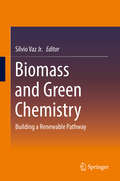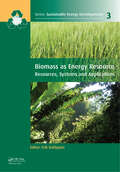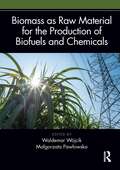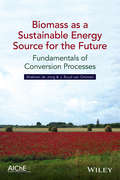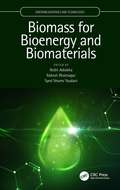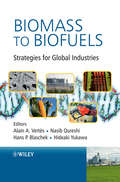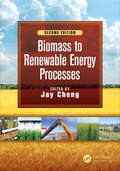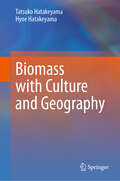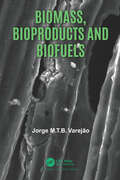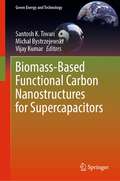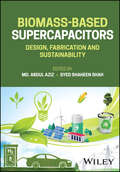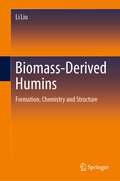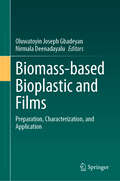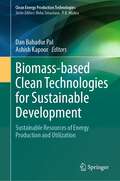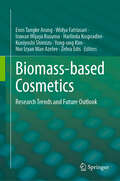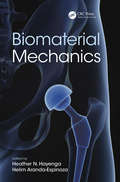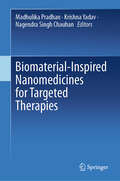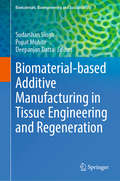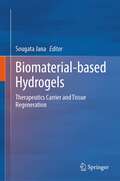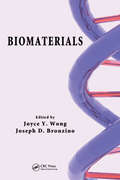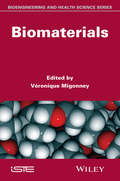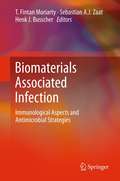- Table View
- List View
Biomass and Green Chemistry
by Sílvio Vaz Jr.This book investigates the main vegetable biomass types, their chemical characteristics and their potential to replace oil as raw material for the chemical industry, according to the principles of green chemistry. Authors from different scientific and technical backgrounds, from industry and academia, give an overview of the state of the art and ongoing developments. Aspects including bioeconomy, biorefineries, renewable chemistry and sustainability are also considered, given their relevance in this context. Furthermore, the book reviews green chemistry principles and their relation to biomass, while also exploring the main processes for converting biomass into bioproducts. The need to develop renewable feedstock for the chemical industry to replace oil has been identified as a major strategic challenge for the 21st century. In this context, the use of different types of vegetable biomass – starch, lignocellulosic, oleaginous, saccharide and algae – can be seen as a viable alternative to the use of non-renewable, more expensive raw materials. Furthermore, it offers a model for adding economic value to the agro industrial chains such as soybean, sugarcane, corn and forests, among others. This will in turn contribute to the sustainability of a wide range of chemicals, mainly organics and their transformation processes, which are widely used by modern society.
Biomass as Energy Source: Resources, Systems and Applications (Sustainable Energy Developments)
by Erik DahlquistGlobal energy use is approximately 140 000 TWh per year. Interestingly, biomass production amounts to approximately 270 000 TWh per year, or roughly twice as much, whereas the official figure of biomass use for energy applications is 10-13% of the global energy use. This shows that biomass is not a marginal energy resource but more than capable of
Biomass as Raw Material for the Production of Biofuels and Chemicals
by Waldemar WójcikFor the power industry, biomass is just a modern name for the ancient material of plant origin that was converted into energy in the simple technology of burning. This book discusses biomass as a raw material for the production of liquid or gaseous biofuels and valuable chemicals. Such biomass processing should be beneficial from both economic and environmental points of view. Classic technologies of biogas production are still being improved, but they always generate waste that differs in terms of chemical parameters, depending on the feedstock digested. These parameters dictate the manner of their final managing. Various biotechnologies allow the use of the biomass of hydrobionts, such as cyanobacteria as a raw substance for obtaining different products, e.g. hyaluronic acid, biopolymers, fertilizers, or even drugs. Animal fats or algae can be used to produce biodiesel which in turn is used in environmentally friendly urban transport. Even municipal solid waste can be a source of useful biomass. The authors show how its volume and composition can be predicted, by which form of processing it can be converted into valuable products, as well as in which ways its negative environmental impact can be limited.
Biomass as a Sustainable Energy Source for the Future
by J. Ruud van Ommen Wiebren De JongFocusing on the conversion of biomass into gas or liquid fuels the book covers physical pre-treatment technologies, thermal, chemical and biochemical conversion technologies* Details the latest biomass characterization techniques* Explains the biochemical and thermochemical conversion processes* Discusses the development of integrated biorefineries, which are similar to petroleum refineries in concept, covering such topics as reactor configurations and downstream processing* Describes how to mitigate the environmental risks when using biomass as fuel* Includes many problems, small projects, sample calculations and industrial application examples
Biomass for Bioenergy and Biomaterials (Emerging Materials and Technologies)
by Nidhi Adlakha Rakesh Bhatnagar Syed Shams YazdaniBiomass for Bioenergy and Biomaterials presents an overview of recent studies developed specifically for lignocellulose-based production of biofuels, biochemicals, and functional materials. The emphasis is on using sustainable chemistry and engineering to develop innovative materials and fuels for practical applications. Technological strategies for the physical processing or biological conversion of biomass for material production are also presented. FEATURES Offers a comprehensive view of biomass processing, biofuel production, life cycle assessment, techno-economic analysis, and biochemical and biomaterial production Presents details of innovative strategies to pretreat biomass Helps readers understand the underlying metabolic pathways and identify the best engineering strategies for their native strain Highlights different strategies to make biomaterials from biomass Provides insight into the potential economic viability of the biomass-based process This book serves as an ideal reference for academic researchers and engineers working with renewable natural materials, the biorefining of lignocellulose, and biofuels. It can also be used as a comprehensive reference source for university students in metabolic, chemical, and environmental engineering.
Biomass in Small-Scale Energy Applications: Theory and Practice (Energy Systems)
by Mateusz Szubel and Mariusz FilipowiczBiomass in Small-Scale Energy Applications: Theory and Practice presents the current trends in the development of selected biomass-based technologies for distributed energy generation. It describes the methodology, experimental results, and computer simulations with a focus on pilot systems and devices crucial in multiple applications with related environmental/economic issues. It describes which stages of design, development, and application of advanced biomass-based energy devices are critical in order for a given technology to be successful. It includes both technical/practical information and theoretical background related to combustion kinetics, thermodynamics in energy systems, and properties of selected types of biomass, as well as case studies.
Biomass in the Bioeconomy: Focus on the EU and US
by Jean-Luc Wertz Serge Perez Philippe MengalBiomass is the physical basis of the bioeconomy, the renewable segment of the circular economy, and as a CO2-neutral part of the carbon cycle, biomass is an efficient carbon sink. Demand for biomass is increasing worldwide because of its advantages in replacing fossil-based materials and fuels, which presents the challenge of reconciling this increased demand with the sustainable management of ecosystems, including forests and crops. This reference book discusses the role of biomass in the bioeconomy and focuses on the European Union and the United States, the first two regions to develop a bioeconomy strategy with an obvious effect on the bioeconomy developments in the rest of the world. Significant developments in other areas of the world are addressed. Features: Provides strategies for optimal use of biomass in the bioeconomy Defines and details sources, production, and chemical composition of biomass Describes conversion, uses, and sustainability of biomass Biomass in the Bioeconomy: Focus on the EU and US will appeal to an interdisciplinary audience of readers working in the fields of chemical and environmental engineering.
Biomass to Biofuels
by Alain Vertes Hideaki Yukawa Nasib Qureshi Hans P. BlaschekFocusing on the key challenges that still impede the realization of the billion-ton renewable fuels vision, this book integrates technological development and business development rationales to highlight the key technological.developments that are necessary to industrialize biofuels on a global scale. Technological issues addressed in this work include fermentation and downstream processing technologies, as compared to current industrial practice and process economics. Business issues that provide the lens through which the technological review is performed span the entire biofuel value chain, from financial mechanisms to fund biotechnology start-ups in the biofuel arena up to large green field manufacturing projects, to raw material farming, collection and transport to the bioconversion plant, manufacturing, product recovery, storage, and transport to the point of sale. Emphasis has been placed throughout the book on providing a global view that takes into account the intrinsic characteristics of various biofuels markets from Brazil, the EU, the US, or Japan, to emerging economies as agricultural development and biofuel development appear undissociably linked.
Biomass to Renewable Energy Processes
by Jay ChengBiomass to Renewable Energy Processes, Second Edition, explains the theories of biological processes, biomass materials and logistics, and conversion technologies for bioenergy products such as biogas, ethanol, butanol, biodiesel, and synthetic gases. The book discusses anaerobic digestion of waste materials for biogas and hydrogen production, bioethanol and biobutanol production from starch and cellulose, and biodiesel production from plant oils. It addresses thermal processes, including gasification and pyrolysis of agricultural residues and woody biomass. The text also covers pretreatment technologies, enzymatic reactions, fermentation, and microbiological metabolisms and pathways.
Biomass with Culture and Geography
by Tatsuko Hatakeyama Hyoe HatakeyamaThis book introduces biomass which is utilized all over the world based on geographical, cultural, and historical background. It covers 18 major biomass types and several specific plants categorized into 3 groups based on their usage. The present and historical background of representative materials from biomass, such as cellulose, lignin, chitin, sugar, molasses, amylose, and other interesting natural biopolymers, such as hyaluronan, gum Arabic, and others are introduced. Furthermore, characteristic features of representative and influential plants, such as rice, eucalyptus, and oil palm are described together with historical episodes. Although physicochemical characteristic properties of each material and plant have been published over many decades, scarcely a comprehensive introduction on biomass together with Asian, European, and Latin American cultural backgrounds. In this book, biomass familiar to everybody’s life is introduced based on scientific and cultural viewpoints. It guides readers to gain background knowledge of targeting biomass to be developed as industrial resources. In addition to students, scientists, and lecturers, the book will be useful for industrial engineers, both specialists in polymer science and technology and materials experts.
Biomass, Bioenergy & Bioeconomy (Microorganisms for Sustainability #35)
by Anita Singh Naveen Kumar Arora Richa KothariThis edited book explores the three interrelated concepts – biomass, bioenergy, and bioeconomy – from the point of view of sustainable advanced conversion processes. It elaborates on processing routes, i.e., how biomass from various sources can be converted into bioenergy like bioethanol, biodiesel, biobutanol, and biogas. Chapters are organized into three sections – “Biomass,” “Bioenergy,” and “Bioeconomy.” The first section very much focuses on biomass-based global research trends and their utilization for future bioenergy options, very particular to microbial activities associated and their practically real-time challenges during lab to land approach. The second section deals with biomass-based applications like biodiesel, bioethanol, biobutanol, biohydrogen, and biomass cookstoves and their future perspectives and challenges. The past, present, and future trends of biomass-based research applications have been assessed and critically evaluated to make the gathered knowledge available in the simplest form for academicians and researchers. The third section focuses on biomass-based policies on implementation and governmental strategies needs a attention to make it smooth for social groups and communities too. The role and impacts of bioeconomy with biomass-based bioenergy options and applications are also targeted here. Sustainable Development Goals are addressed in this section to achieve three objectives (trio), i.e., social, economic, and ecological status, which are the need of the hour for bioeconomic security. Contributions of bioenergy to environmental security have also been addressed in this section, very particular to linkage of sustainable human development. This book is a useful compilation of latest information for researchers and teachers in bioenergy and microbiology. The book also serves as reading material for undergraduate and graduate students of environmental sciences, microbiology, and bioenergy.
Biomass, Bioproducts and Biofuels
by Jorge M.T.B. VarejãoDue to its depletion and the environmental damage it causes, hydrocarbons are being replaced by energy from renewable sources. One such form of energy source is Biomass. Biomass is a renewable raw material generated by living organisms and found in agricultural waste in large quantities. The three main components of biomass are cellulose, hemicellulose and lignin. The first two components are sugar polymers, being cellulosic ethanol a desirable goal for converting those. The truth is that the production of cellulosic ethanol has never passed the pilot unit phase, due to the lack of economic competitiveness. New ways must be found to make this viable. From the latest finding of the biomass structure, new biomass processing pathways are being advanced, constituting new biorefinery models, which will make it possible to obtain cellulosic ethanol concomitant with the production of different bioproducts such as xylitol, oligosaccharides, antioxidants and analogues to carbon fiber, etc. Lipid rich biomass is the source of foods oils. With population growth, the amounts of waste volume will increase. It is important to improve the processes of valorization of these residues, through their conversion into alcoholic esters of fatty acids, which can be used as fuel or in other domestic and industrial applications. This volume reviews advances and innovative applications in this field. It will encourage the use of new works and even unpublished works to use biomass or its components for the production of bioproducts and biofuels.
Biomass-Based Functional Carbon Nanostructures for Supercapacitors (Green Energy and Technology)
by Vijay Kumar Santosh K. Tiwari Michal BystrzejewskiThis book presents a widespread description of the synthesis and characterization of biomass-based carbon nanostructures. It also covers the vital applications of these materials in supercapacitors and for next-generation energy storage devices. It describes the common design procedures, advantages and disadvantages of biomass-based carbon nanostructures and offers novel visions into the forthcoming directions. In addition, this book will provide new updates about the effect of doping and structural twist on the electrochemical performance of electrode materials derived from biomass sources. The book will be useful for beginners, researchers, and professionals working in the area of carbon nanomaterials and their applications in energy storage devices.
Biomass-Based Supercapacitors: Design, Fabrication and Sustainability
by Syed Shaheen Shah Md. Abdul AzizBIOMASS-BASED SUPERCAPACITORS Authoritative resource addressing the fundamentals, design, manufacturing, and industrial applications of supercapacitors based on biomass Biomass-Based Supercapacitors presents a systematic overview and recent developments in the research, design, and fabrication of supercapacitors using biomass, discussing fundamentals, advancements, industrial applications, and the manufacturing process of biomass-derived supercapacitors. The text also considers environmental and economic aspects of the technology, along with biomass-based supercapacitors in the context of circular economy. Written by a team of international experts in the field of supercapacitors, Biomass-Based Supercapacitors covers sample topics such as: Basic foundational knowledge surrounding supercapacitors, electrochemical techniques for supercapacitors, and different types of supercapacitors Biomass derived electrode materials for supercapacitors, such as activated and non-activated carbon, carbon from pretreated biomass, carbonate salts-activated carbon, and more Electrolytes, separators, and packaging materials for supercapacitors using biomass and binding materials from biomass for supercapacitors Future outlooks and challenges for the development of biomass-based supercapacitors, from the lab to practical applications in industry Biomass-Based Supercapacitors is an excellent resource for academic researchers and industrial scientists working in the areas of supercapacitor fabrication, energy materials and energy storage devices, electrochemistry, materials science, biomass conversion, green chemistry, and sustainability.
Biomass-Derived Humins: Formation, Chemistry and Structure
by Li LiuThis book provides a unique perspective on atom economical utilization of biomass resources into value-added productions. Humins are inevitably formed during the process of biomass conversion, which compete with desired products, restrain the activity of catalyst and hinder the recycling of catalyst and separation of products. To further improve the efficiency of biomass conversion toward downstream products, unambiguous elucidation of the chemical structure and formation mechanism of humins are prerequisite. This book primarily presents the chemical structure analysis and formation mechanism of various biomass-derived humins, from simple molecular models to raw biomass resources. The chemical similarities and differences of various biomass-derived humins have been systematically summarized according to advanced analytical interpretation, which offers a comprehensive viewpoint for readers with chemistry, engineering and material backgrounds. Furthermore, the progress that has been achieved on humins valorization and future perspectives are discussed. Given its scope, this book can be treated as an informative resource for undergraduates, postgraduates, lecturers and researchers interested in biomass conversion from academia and industry from entry to professional levels.
Biomass-based Bioplastic and Films: Preparation, Characterization, and Application
by Oluwatoyin Joseph Gbadeyan Nirmala DeenadayaluThis book provides a platform for researchers, engineers, and manufacturers to conceptualize green ideas for sustainably developing plastics and films from biomass and agricultural waste. The upscaling of sustainable bioplastic production is essential for the economic growth of industries and local communities as a means to tackle waste management issues. Therefore, this book acts as a guide to characterize various methodologies and applications for producing usable bioplastic products that will lift the burden imposed by excessive industrial waste pollution. This framework will not only contribute to support the health and management of local communities impacted by waste pollution, but will also support businesses economically through efficient and sustainable recycling practices. This work will inform readers in academia, business, and government sectors with the knowledge needed to control the waste generated from various sources and transfer them to valuable products.
Biomass-based Clean Technologies for Sustainable Development: Sustainable Resources of Energy Production and Utilization (Clean Energy Production Technologies)
by Dan Bahadur Pal Ashish KapoorThis book explores the comprehensive world of biomass-based clean technologies for sustainable development. The meticulously curated book delves into the latest advancements, process and product development aspects, and socio-techno-economic viability of biomass-derived solutions. The book aims to explore cutting-edge strategies and innovative approaches to revolutionize energy and environmental sectors on a global scale. The book covers a wide range of scientific and technological fields, shedding light on the utilization of agricultural and forest-derived biomass. Multifarious applications in biofuels, biochar, natural composites, construction materials, and value-added chemicals are explored. The book is an attempt to impart knowledge to address challenging aspects like feedstock variability, supply chain management, process optimization, product standardization, environmental impact, net carbon footprint, and economic viability. By fostering interdisciplinary collaboration and harnessing the renewable nature of biomass, this book offers a holistic approach to develop novel and sustainable solutions. Researchers, scientists, engineers, and professionals from diverse backgrounds will find this book to be an invaluable resource. Policymakers and industry leaders seeking to drive the adoption of clean and green technologies will gain crucial insights. Students and academics will benefit from the latest advancements in biomass-based clean technologies, process and product development aspects, and sustainability assessments. This book is an essential companion for those dedicated to shaping a greener future and will inspire public-private collaborations and innovative research endeavours.
Biomass-based Cosmetics: Research Trends and Future Outlook
by Widya Fatriasari Enos Tangke Arung Irawan Wijaya Kusuma Harlinda Kuspradini Kuniyoshi Shimizu Yong-Ung Kim Nur Izyan Wan Azelee Zehra EdisThis book highlights the potential of biomass for cosmetics applications. It covers the discussion on biomass as a source for cosmetics from savanna, marine and tropical forest, trend and market outlook of biobased cosmetics, active substances from biomass for cosmetics, extractives from biomass for cosmetics, other non-wood forest products such as essential oil, tengkawang, and bee pollen. Besides that, the potency of biopolymers such as lignin, and polysaccharides are presented. The book also discusses activated carbon as a cosmetic source. To present more comprehensive information, it covers biomass as anti-aging, anti-acne, sunscreen, anti-melanin, and antimicrobial. Regarding the close contact system with the human in daily life, cosmetic needs to comply with the human system. Therefore, one special chapter is dedicated to presenting the compatibility view of biobased cosmetics in the human body system. Nanomaterials in cosmetics have started to be used by many beauty companies asindicated by nano-related patents. The nanotechnology applications in cosmetics also provide future trends in bio-based cosmetics. Some forms of nanomaterials that have been reported include liposomes, nanoemulsion, nanocapsules, solid lipid nanoparticles, nanocrystals, nano-silver, nano-gold, hydrogel, etc. Iodinated Aloe Vera formulations within polymeric complexes present examples of bio-antimicrobials and such compounds are at the crossroads between pharmaceutics and cosmetics. Finally, the environmental and safety impacts of biobased cosmetic development are discussed as the closure in the last chapter.This book is expected to provide insightful information for those dealing with biomass or doing research on biomass for sustainable living. Moreover, it is also suitable for policymakers to get the new and latest information on valorizing local biomass while expanding its usage for cosmeceutical purposes. Due to the current environmental problems occurring in our surroundings, this book is seen to be an important tool to spread awareness of the smart way of utilizing our precious biomass and transforming it into valuable products.
Biomaterial Mechanics
by Helim Aranda-Espinoza Heather HayengaThis book describes the fundamental knowledge of mechanics and its application to biomaterials. An overivew of computer modeling in biomaterials is offered and multiple fields where biomaterials are used are reviewed with particular emphasis to the importance of the mechanical properties of biomaterials. The reader will obtain a better understanding of the current techniqus to synthesize, characterize and integrate biomaterials into the human body.
Biomaterial-Inspired Nanomedicines for Targeted Therapies
by Nagendra Singh Chauhan Madhulika Pradhan Krishna YadavThis book delves into the burgeoning field of nano-biomaterials and their application in targeted drug delivery across various therapeutic domains. Through its comprehensive exploration, it offers insights into the innovative approaches and potential of biomaterial-inspired nanomedicines in revolutionizing healthcare. Chapter 1 introduces readers to the fundamental concepts of biomaterial-inspired nanomedicines, laying the groundwork for subsequent discussions. Chapter 2 delves into the utilization of nano-biomaterials in tissue engineering, highlighting their role in regenerative medicine. The book further examines the targeting of specific physiological barriers, such as the blood-brain barrier (Chapter 3), and explores the opportunities and challenges in biomaterial-based vaccine delivery (Chapter 4). Additionally, it discusses the use of nano-biomaterials in addressing pulmonary obstruction (Chapter 5) and targeting the tumor microenvironment for chemotherapy (Chapter 6). Chapters 7 to 16 explore various therapeutic applications of nano-biomaterials across different medical conditions, including autoimmune skin disorders, diabetes, wound healing, central nervous system disorders, ocular diseases, infectious diseases, musculoskeletal disorders, and gastrointestinal diseases. Furthermore, the book sheds light on advances in nano-biomaterials for effective antimicrobial therapy and offers insights into the clinical and regulatory considerations associated with their use (Chapter 17). By encompassing a wide range of topics and providing in-depth analyses, "Biomaterial-Inspired Nanomedicines for Targeted Therapies" serves as a valuable resource for researchers, practitioners, and policymakers aiming to leverage the potential of nano-biomaterials in improving healthcare outcomes.
Biomaterial-based Additive Manufacturing in Tissue Engineering and Regeneration (Biomaterials, Bioengineering and Sustainability #7)
by Sudarshan Singh Popat Mohite Deepanjan DattaBiomaterials are substances that are engineered to interact with biological systems for medical and therapeutic purposes. Biomaterial-based additive manufacturing in tissue engineering is a rapidly evolving field with ongoing research and development. As technology advances, it is likely to play a pivotal role in the development of regenerative medicine and personalized healthcare. Biomaterial-based additive manufacturing, also known as 3D bioprinting utilizing biodegradable or bioavailable polymeric materials, is a cutting-edge technology with great potential and promise for tissue engineering and regeneration. This innovative approach combines biomaterial or engineered biomaterials with precise or customized printing to develop a complex three-dimensional structure that mimics the architecture and functionality of native tissues. An important aspect in development of 3D printed products for tissue engineering or regeneration is selection of biomaterials, development of bio inks using those biomaterials, cell integration, customization, vascularization, and biodegradability of the product. Although 3D bioprinting has shown promise in various applications with potential to revolutionize organ transplantation and tissue engineering, there are several challenges such as ensuring proper vascularization, improving the mechanical properties of printed products, and addressing regulatory aspects with ethical consideration. Therefore, in this book emphasis on tissue engineering and regeneration will be presented, which is an interdisciplinary field that aim to restore, repair, or replace damaged or lost biological tissues. Moreover, chapters inform on recent shift in research that indicates a customized fabrication of biodegradable products, the future of tissue engineering and regeneration.
Biomaterial-based Hydrogels: Therapeutics Carrier and Tissue Regeneration
by Sougata JanaThis book highlights recent advances in natural and synthetic biomaterials-based hydrogel for drug delivery carriers and tissue engineering. It covers key topics such as chitosan, alginate, gelatin, cyclodextrin, cellulose, starch, hyaluronic acid, dextran, collagen hydrogel, Injectable hydrogel magnetic hydrogel, DNA-based hydrogels, 3D printing of hydrogels, hydrogel for bone tissue engineering and regenerative medicine, etc. Each chapter develops a particular aspect of recent advances in biomaterial-based Hydrogels delivery systems to cover the importance, fabrication technology, characterization, evaluation, delivery of therapeutic and biomedical applications, and future perspectives. Written by a group of renowned scientists, chemists, biologists, and engineers from around the world, the book is designed as an important reference resource for scientists and researchers working on advanced biomaterials in the fields of pharmaceuticals, biomedical science, biomedical engineering,nanotechnology, and material science for most updated findings and future research trends.
Biomaterials
by Joseph D. Bronzino Joyce Y. WongFor medical devices that must be placed inside the body, the right choice of material is the most important aspect of design. To ensure such devices are safe, reliable, economical, and biologically and physiologically compatible, the modern biomedical engineer must have a broad knowledge of currently available materials and the properties that affe
Biomaterials
by Véronique MigonneyDiscovered in the 20th century, biomaterials have contributed to many of the incredible scientific and technological advancements made in recent decades. This book introduces and details the tenets of biomaterials, their relevance in a various fields, practical applications of their products, and potential advancements of the years to come. A comprehensive resource, the text covers the reasons that certain properties of biomaterials contribute to specific applications, and students and researchers will appreciate this exhaustive textbook.
Biomaterials Associated Infection: Immunological Aspects and Antimicrobial Strategies
by Henk J. Busscher Sebastian A.J. Zaat Fintan MoriartyBiomaterials associated infection (BAI) is one of the most common complications associated with implantation of any biomaterial regardless of form or function. These infections usually involve bacterial colonization and biofilm formation on the biomaterial itself, rendering the infection impervious to antimicrobials and host defenses. In addition, it is becoming increasingly clear that infection of the surrounding tissues also plays an important role in BAI, and that the infection may be influenced by the composition and design of the implanted biomaterial. In this book, worldwide leaders in the field address this critical problem in the translation of biomaterials research into clinical practice. The book begins with an emphasis on the latest research in the pathogenesis of BAI from microbiological, immunological, and materials science perspectives. The current state of the art in antimicrobial activation of biomaterials through surface modification and the incorporation of antimicrobial agents is then discussed. In the concluding chapters, successful translation of a selection of antimicrobial technologies from preclinical research into clinical use is described alongside a discussion of the utility of these devices and perspectives for future development. This book is essential reading for researchers and clinicians who are interested in understanding the fundamentals of BAI, the latest in antimicrobial materials research, and the state of the art in clinically available antimicrobial containing medical devices.
